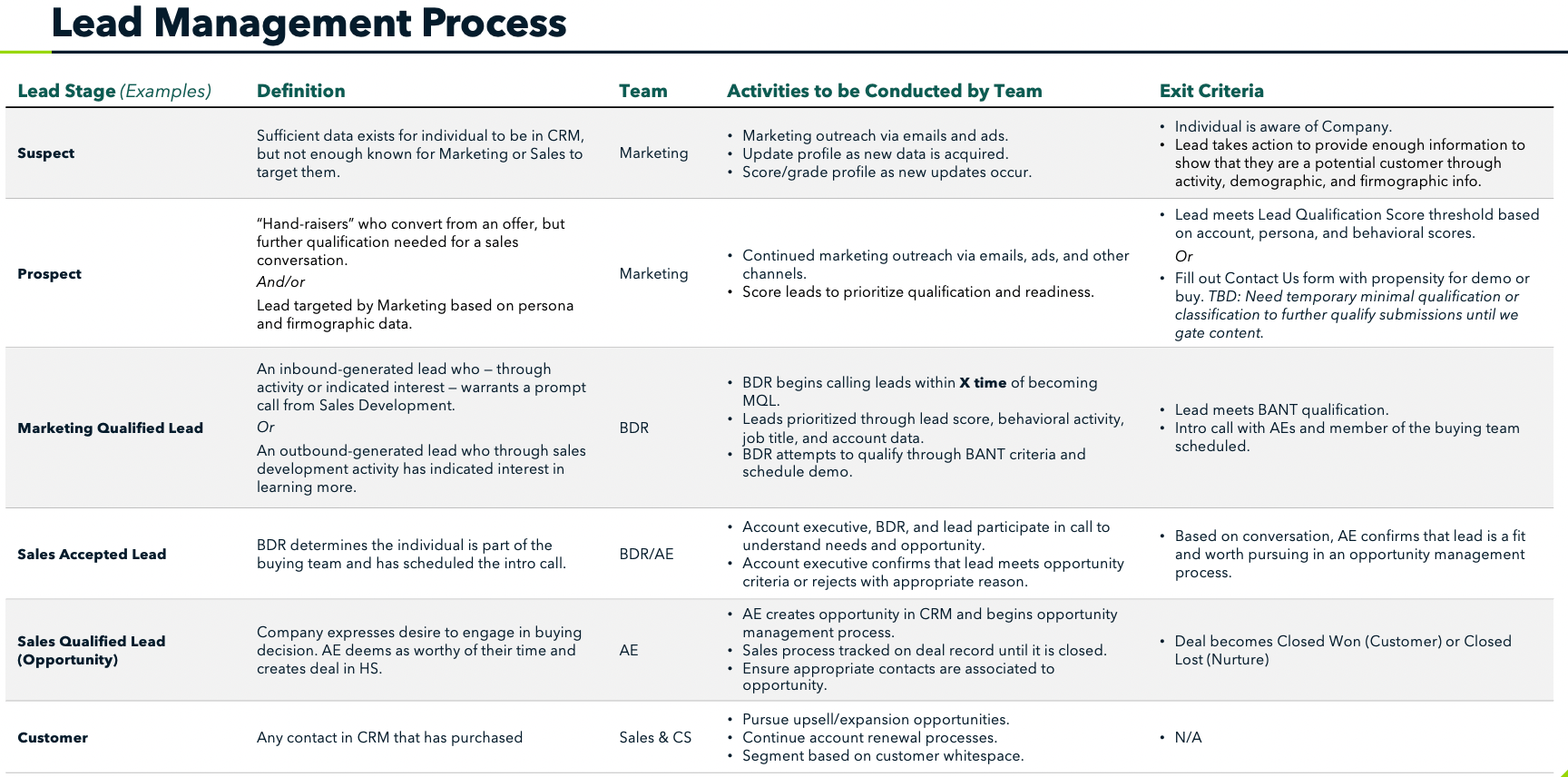Your company’s lead management process is the main artery of your Go-to-Market (GTM) and Marketing processes. With a healthy lead management process, your company can function effectively and grow quickly. Conversely, a poor lead process negatively impacts other GTM processes and will stagnate, causing erroneous insights from bad data.
As you begin to unify lead management processes, there will be natural comparisons to past performance. This is important because stakeholders (like the board) will draw incorrect conclusions about weaknesses that you don’t actually have. This article will help you unify your lead management process, giving you an apples-to-apples comparison across your entire business. This allows your marketing process to become more refined and accurate than what would be possible with distinct and discrete lead management processes.
What is the Lead Management Process?
What do we mean by “lead management process”? It’s the stages you define from your company’s perspective on how a lead should move through the funnel. With a healthy lead management process, you’ll know where every lead in your customer relationship management (CRM) software is in the funnel. At any given moment, you’ll know how close your leads are from not-in-market through purchase. These “lead stages” or “lifecycle stages” can be named whatever makes the most sense for your company, as long as they convey the same points. At Cortado we (generally) default to these common terms or similar:
Stages of the Lead Management Process
- Suspect (or Prospect)
- Marketing Captured Lead
- Marketing Qualified Lead
- Sales Accepted Lead
- Sales Qualified Lead (or Opportunity)
- Customer
Knowing where individuals are in the funnel helps you to know what communication you should execute and when. Your team will be following a unified lead management process with clearly defined criteria and objectives for each lead. They will know how to engage with an individual at that particular time and what desired outcomes are required. This will create an efficient flow to move leads through the funnel. You will know how effective your current efforts are, particularly where leads convert effectively and where they don’t.
Understanding the Urgency of a Unified Lead Management Process
A unified lead management process across your GTM teams is table stakes to effective decision-making. With everyone speaking the same language, your communication with your clients is seamless and you can effectively coach your team. Your data will be accurate and your CRM will paint a clear picture of what’s actually happening.
Things get complicated, especially in the private equity world, when merging acquired company lead management processes. There will always be a gargantuan list of things for you to do as a CEO during an acquisition. At the top of that list should be unifying the new company’s lead management process. In most cases this will be with your own process, unless the acquired company has a demand gen engine you want to leverage. More often than not, the acquiring company has the stronger demand gen engine. The rest of this article will explain why this needs to be a priority and how to get started.
Why Your Newly Acquired Company Must Unify Their Lead Management Process
Your newly acquired company likely has a very different lead management process than your acquiring company. They may have defined Marketing Qualified Leads (MQLs) very differently from how you define them now. Maybe their stages are completely different from yours. Perhaps their lead process (and this happens all too often) is non-functional—if it even exists at all. Nearly 100% of the time you will need to unify lead management processes when you acquire a new company, assuming that there are lead management processes in place to unify.
Your acquired team will synchronize more effectively when they speak the same language. If your team says they’ve generated 500 MQLs from company A and 250 MQLs from newly acquired company B, how do you know which is more effective? How do you know where to invest more dollars? Are company B’s MQLs more likely to convert than company A’s, thus potentially influencing your close rate? If you can’t make accurate comparisons, then you’re relying on gut assumptions that aren’t backed by actual data. That apples-to-apples comparison can only happen if you develop a unified lead management process. To clarify the example, company A’s MQLs and company B’s MQLs must unify and operate under the same definition, otherwise, the data will be inaccurate or unclear to the point of uselessness.
If your lead management process isn’t unified, then your data will be inconsistent. You lose nearly all ability to cross-sell effectively. Your managers will have nightmares trying to coach their sales teams on effective selling. Your RevOps team can’t provide the data and insights needed to understand the effectiveness of your GTM efforts. And from your prospects’ point of view, your messaging will be disjointed, convoluted, and unclear. Every step in the marketing process will be affected if you’re unable to cinch this step.
Getting Started: Unifying Your Lead Management Process
So where should you and your team start? There are four basic steps to unifying any lead management processes:
- Analyze and document current lead management processes
- Strategically unify those processes
- Implement changes into the CRM
- Train your team
As a CEO, you should be intimately involved with these first two steps. The rest of this article will focus on those two points. Before you can build your process, you need to develop the strategy and groundwork behind it.
Step 1. Analyze and Document the Current Lead Management Processes
Your first order of business is to get a deep understanding of the current lay of the land. This includes documenting your company’s current lead management process and that of the company you have acquired/merged.
This can be done by creating a table in PowerPoint or Google Slides. Creating a slide will make this document more visual and organized when you share it with the board and your teams. Across the top row, create headers for “Stage, Definition, Team, Activities to be Conducted, Exit Criteria”. Down the first column, write the names of your lead process stages. Now you will have a matrix of your stages with the key attributes of each stage. The idea here is that your team can come to understand what happens to a prospect at each stage and how to move them forward. Do this same exercise for each lead management process that you will be unifying together.
Remember that building this document is not a solo job done by you or anyone else. Developing the lead management process is a highly collaborative effort that requires discussion between marketing and sales leadership. Input from the front-line sales and marketing team is also extremely valuable. Creating this document takes several iterations and multiple meetings of deliberation. Each iteration of input helps build buy-in.
The most important purpose of this document is alignment. By the end of the process, your marketing and sales teams need to agree that this is the go-forward lead management process. In these strategy meetings, ask provocative questions to your leaders about how stages should be defined. Document the activities that are being done or should be done by your team. The most important column on the table is the “Exit Criteria”. Align your teams on what criteria must be met before the prospect can qualify for the next stage.
Step 2. Strategically Unify Lead Management Processes
Now that you have a defined lead management process for each company, merge and align those processes together. This task can be a difficult step. The company you recently acquired may have a similar or complementary ideal customer profile as you. They may have an entirely different target which could make this more of a challenge.
Remember that your number one goal is alignment. You’ll want current marketing and sales leaders in discussions with the newly acquired company’s leadership (if possible). Pull up all lead and management processes that have been developed and discuss how they can be unified. What nuanced criteria or definitions need to be adjusted to account for the majority of scenarios?
Again, ask provocative questions to the team that encourages discussion around unifying these processes. Make sure that the team understands the importance of the development of this strategy. Without their buy-in, change management will be nearly impossible. Tell them that with a unified process, all teams will speak the same language. Reps will have a clear path forward when working with prospects which will greatly enhance their effectiveness. Managers will have clear visibility into the funnel and how to make marginal gains to increase revenue. The marketing process will be clearer and more comprehensible for everyone who interacts with it.
Steps 3 and 4. Implementation and Training
With the lead management process now defined and unified, your job is not yet done. Now it’s time to get the strategy from paper and into practice.
Our final two steps are to implement the changes into the CRM and train your team. As the CEO, you’ve put in a lot of work in developing the strategy, but it’s important to rely on your RevOps team. They will know the best path forward to operationalize the process into your CRM. Clearly articulate to them how the new process is defined.
- Prompt them to build CRM enhancements that would make this process as efficient as possible for the sales team.
- Remind them that process unification might include migrating or updating data from an old process to the new requirements.
- Rely on their expertise and skill set to build and optimize.
- Work with them to ensure that the standards needed for a new lead management process are met.
Leverage your sales, marketing, and sales enablement leaders to train your team on the new process. Your leaders will feel more accountable to the process and will make greater effort to ensure alignment. Give time to your RevOps or Sales Enablement team to train on the procedural changes in the system. Having you in those meetings will help the team realize the importance of the new process. Take the opportunity to clarify and reinforce responsibilities and alignment.
A Word to the Wise
There will always be growing pains to any significant process change. As it relates to changing and unifying your lead management process, there is often an adjustment period needed. Also, be aware that the performance of metrics associated with your lead funnel are also likely to change. Your unified lead management process is now a more realistic representation of your funnel as a whole. However, the perception of success amongst your team and board might not have changed yet. Let’s look at a few scenarios that exemplify potential situations:
- Scenario 1: Your newly developed lead stages call for a higher level of qualification. You ask your sales reps to have more strategic conversations earlier in the funnel before nailing down timing and budget. Close rates dip as a result. However, better conversations with prospects yield a higher Average Sales Price and more strategic future opportunities with customers.
- Scenario 2: You find that after changing your lead process, marketing generates fewer opportunities per month. You quickly realize that previously, the sales team was going after too many unqualified opportunities. A tighter lead management process will bring in fewer, but more qualified companies. As they operate under the newer process, win rates will increase and reps’ time will be more efficient.
As you can see, a unification of lead processes might bring an unexpected change in the performance of one metric. However, that unexpected change will lead to another desired outcome that is more significant long term. Ultimately, whether it results in a growth in overall leads or a growth in the percentage of leads converted, a unified lead management process is key to understanding the strengths and weaknesses of your marketing process.
Final Thoughts
Remember that unifying lead management processes will always be messy. It’s about unifying processes and aligning teams so expectations and desired outcomes are clearly set. Don’t be discouraged if change is difficult at first. If your lead management process is built right, it should click quickly with your teams and they’ll be quick to adapt. Soon, you’ll be seeing great improvements in your sales team’s efficiency and effectiveness.
We hope this article served as a helpful guide. If you need something a little more tangible to get started, download our lead management process starter template. If you’re interested in learning more about how Cortado can help you unify your GTM processes, feel free to schedule a call.




